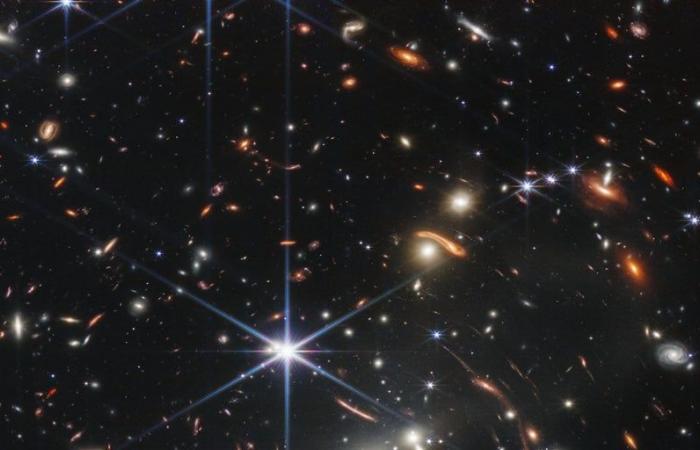For decades, cosmology, the branch of astronomy that studies the origin and evolution of the universe, faces a persistent enigma known as the ‘Hubble tension’. It is an uncomfortable discrepancy that inevitably arises when trying to measure speed … to which the universe expands. There are two different methods to do so, both proven to satiety by scientists, but the values obtained by each of them simply do not coincide. Something for researchers, for the moment, find no explanation.
Now, a new work led by István Szapudi, from the University of Hawaii, and published in ‘Monthly Notices of the Royal Astronomical Society’, proposes a surprisingly simple, radical solution: although radical: what if the entire universe, in addition to expanding, was also turning?
The researchers, in effect, suggest in their article that a slow cosmic turn could be the key that we needed to harmonize contradictory measurements of universal expansion. The supposed rotation, so slow that it would take the amazing amount of 500,000 million years to complete a single round, it would be enough to make ‘fit’ the pieces of the puzzle without violating any known law of physics.
Hubble tension: a cosmic disagreement
But what exactly is Hubble tension? In 1929, astronomer Edwin Hubble discovered that the universe was not static, as thought then, but that it expanded, becoming bigger and bigger. Idea that became one of the pillars of modern cosmology. Hubble, in fact, observed that the galaxies move away from us, and realized that the further they are, the faster they seem to do so.
This relationship is quantified by the so -called ‘hubble constant’, a number that describes precisely that expansion rate. The problem arises when, to measure that constant, different methods are used. Thus, on the one hand we have the observations of the ‘modern’ universe, or close, which are based on the study of IA type supernovae. These cataclysmic explosions of morbundas stars are incredibly bright, and have the enormous advantage that they all reach a peak of almost identical luminosity, which makes them excellent ‘standard cosmic candles’ cosmic to measure great distances.
By measuring their apparent brightness from the earth, in fact, researchers can calculate the distance of those supernovae and, combining it with their speeding speed, obtaining a value for the Hubble constant.
On the other hand, we have the measurements based on the cosmic microwave background (CMB), a weak radiation that floods everything and that is an ‘echo’ of the Big Bang, the oldest light in the universe, emitted just about 380,000 years after its birth. Small temperature variations in the WBC contain crucial information about the conditions of the primitive universe, including its expansion rate in those distant times. Using our current cosmological models, we can project this early expansion rate to the present to obtain a value for the Hubble constant.
As has been said, the paradox, or tension, of Hubble is that the values obtained by these two methods do not coincide. Thus, the measurements of the nearby universe (using Supernovas), show a value of the Hubble constant slightly higher than the CMB observations. It is as if we measure the speed of a car with two different radars and had different results. The discrepancy, although apparently small (around 10%), has deep implications for our understanding of the universe and has led some cosmologists to speak of a possible ‘crisis’ in the standard model of cosmology, the best theory we have about the origin and evolution of the universe.
A slow turn that changes everything
To try to solve the problem, the Szapudi team explored the possibility that the standard model, according to which the universe expands uniformly in all directions, could need a slight modification. So they introduced an element of rotation in their calculations, based on the simple idea that, if planets, stars and galaxies turn, why couldn’t the entire universe be doing it also?
The result was surprising. Szapudi discovered that adding a rotation, even one as incredibly slow as one lap every 500,000 million years, was enough to close the gap between the different measurements of the expansion. The turn, however small, would subtly affect the way in which space expands over time and in different directions, which could explain why measurements based on the primitive and late universe differ from each other.
«Paraphrasing the Greek philosopher Heraclitus -says Szapudi-, who said ‘Panta Rhei’, everything flows, we think that perhaps the most correct is ‘Panta Kykloutai’, everything turns». According to the authors, the most remarkable thing about this proposal is that it does not require an exotic ‘new physics, nor does it need to violate the principles of Einstein’s general relativity. It simply suggests a slightly more complex cosmic dynamic than we had assumed. Namely, the universe not only expands ‘out’, but it could also be experiencing a slight torsion movement.
An idea with history
The idea of a rotating universe is not completely new in the history of cosmology. In fact, the mathematician Kurt Gödel, friend and colleague of Albert Einstein, already explored this possibility in 1949. Gödel, in effect, demonstrated that the equations of general relativity allowed, in principle, the existence of a rotation universe. His model, although theoretical and with strange properties such as the possibility of traveling over time, showed that a rotating cosmos was mathematically consisting within the framework of Einstein’s physics.
Later, figures such as Stephen Hawking also considered universes in rotation in their research on the origins and structure of the cosmos. And now, Szapudi’s work and his team take up the idea and apply it directly to one of the most pressing observational problems of current cosmology.
Looking for the footprint of cosmic rotation
Although the mathematical model is promising, the proposed rotation is so slow that its direct detection, an essential step to confirm the idea, is extremely difficult with current technology. A turn of 500,000 million years is unimaginable to human scales, or even galactic (our Milky Way takes, compared, only ‘230 million years to make a complete turn).
Therefore, researchers plan to develop much more detailed simulations that identify and allow the subtle ‘signatures’ of this cosmic rotation in observational data. Signatures that could manifest as small distortions in the cosmic microwave background, unexpected patterns in gravitational waves, or irregularities in the distribution and structure of galaxies that are not explained by the current standard model.
If future observations manage to confirm the existence of this cosmic turn, the impact would be enormous in our understanding of the universe, since it would force a review, even if it was subtle, of the standard cosmological model and would open new routes of research on the large -scale dynamics of the cosmos in which we live.






